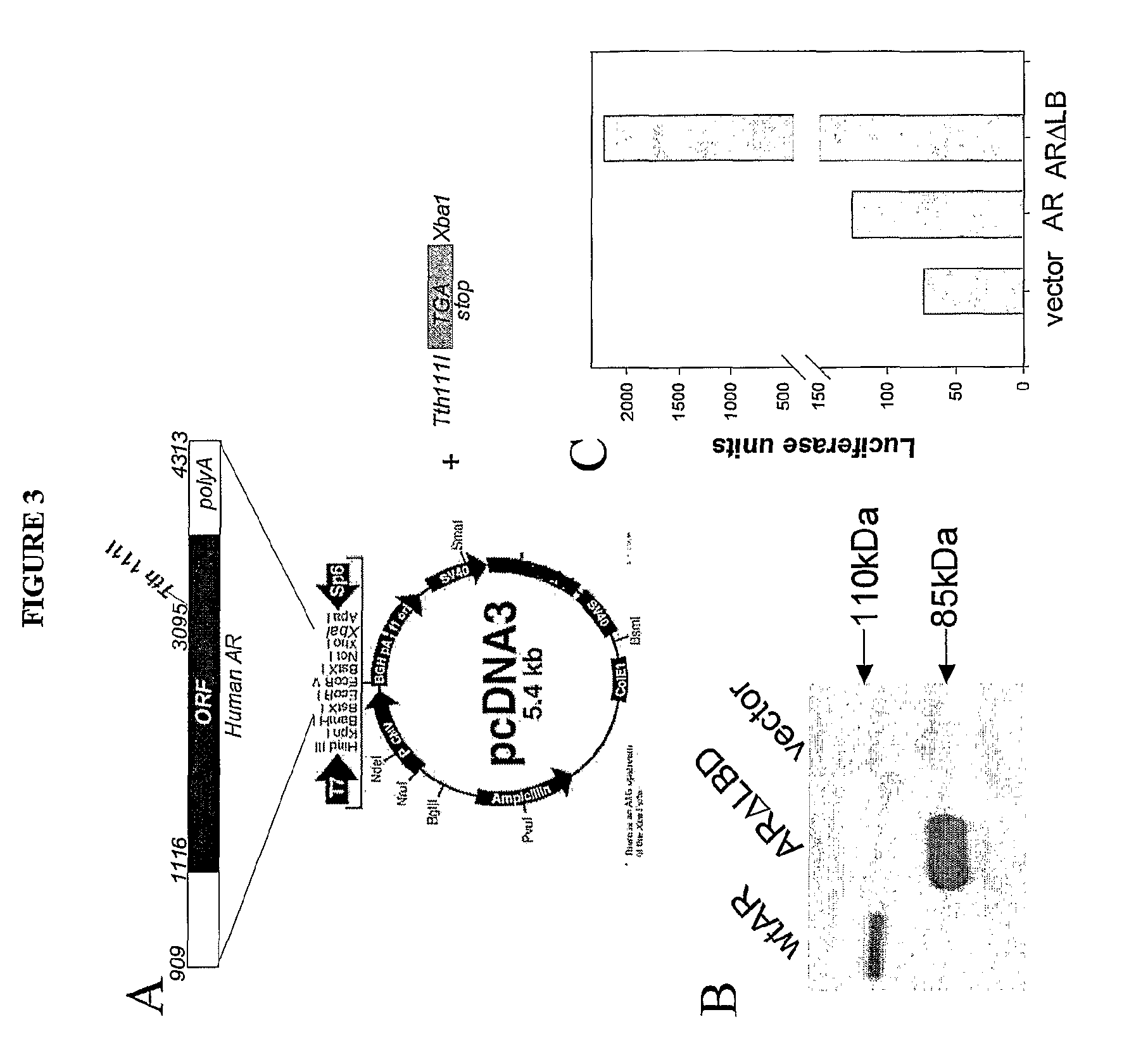Modulation of Androgen Receptor for Treatment of Prostate Cancer
a technology of androgen receptor and treatment, applied in the field of cell signaling modulation, can solve the problems of refractory to antiandrogens, losing their efficacy, and former cell lines do not seem to adequately reflect the situation
- Summary
- Abstract
- Description
- Claims
- Application Information
AI Technical Summary
Benefits of technology
Problems solved by technology
Method used
Image
Examples
example 1
AR Reporter Construct
[0085]The ARELuc vector containing an AR reporter construct ARELuc (FIG. 2A) was prepared. Human AR, subcloned into pcDNA3Zeo vector was cut with BamH1 and Tth111I restriction enzymes. The fragment of AR corresponding to nucleotides 909-3095 of human AR (NM00041) was ligated with short oligonucleotide providing a stop codon through Tth111I cohesive ends and then cloned back into the pcDNA3.1Zeo vector using BamH1 and Xba1 sites. This fragment was also subcloned into lentiviral vector pLV.
[0086]The promoter contained a cassette of three androgen responsive elements (ARE) derived from the promoter of the rat probasin gene. The promoter also contained the Hsp70 minimal promoter, which by itself showed barely detectable background expression in prostate cell lines (data not shown). The gene encoding luciferase was used as a reporter gene under the control of the promoter. The reporter construct was flanked by two insulator sequences and includes a selectable marker ...
example 2
Evaluation of LnCaP, C4-2 and CWR22R
[0088]We tested the AR reporter construct in three prostate cancer cell lines: LNCaP, C4-2 and CWR22R. Androgen-dependent LNCaP cells and their derivative C4-2 are derived from a xenograft of LNCaP cells grown in castrated animals. CWR22 cells are grown as a xenograft in mice, while their androgen-independent derivative CWR22R may be grown in culture. The AR gene in LNCaP-C4-2 pair has the same mutation in the ligand-binding domain (threonine→alanine at residue 877), which is frequently found in prostate cancer patients. CWR22 cells have another hot spot codon mutated (histidine→tyrosine at residue 874), while CWR22R cells acquired additional mutations (Leu→Gln at residue 57, Glu→Asp at residue 635), and a duplication of the third exon.
[0089]We transduced each cell type with the ARE-Luc reporter and tested the dependence of reporter activity on the presence of androgens and other ligands present in fetal bovine serum (FBS). We plated the cells in ...
example 3
Ligand Independent Mutant of AR
[0090]We sought to produce a more completely androgen-independent prostate cancer cell line by introducing a rationally designed AR mutant that would be more completely ligand independent. We chose to generate prostate tumor-derived AR mutants completely lacking the ligand-binding domain (LBD). We generated a truncated mutant (AA 1-659) and cloned it into pcDNA3zeo and lentiviral plasmid pLV (FIG. 3A). Expression of the ARΔLBD mutant was confirmed by a Western blot analysis of cell extracts after transfection of ARΔLBD as well as wild type AR into HeLa cells. We visualized ARΔLBD using antibodies targeted to the N-terminus of AR (85 kDa band, FIG. 3B). We tested the transactivation function of ARΔLBD mutant by cotransfection of this mutant together with the ARE-Luc plasmid into AR negative HeLa cells. As shown in FIG. 3C, the AR mutant was more than 10× active in the absence of any steroids compared to wtAR.
[0091]Dose-response analysis of ARΔLBD and wt...
PUM
| Property | Measurement | Unit |
|---|---|---|
| Fraction | aaaaa | aaaaa |
| Refractory | aaaaa | aaaaa |
Abstract
Description
Claims
Application Information
 Login to View More
Login to View More - R&D
- Intellectual Property
- Life Sciences
- Materials
- Tech Scout
- Unparalleled Data Quality
- Higher Quality Content
- 60% Fewer Hallucinations
Browse by: Latest US Patents, China's latest patents, Technical Efficacy Thesaurus, Application Domain, Technology Topic, Popular Technical Reports.
© 2025 PatSnap. All rights reserved.Legal|Privacy policy|Modern Slavery Act Transparency Statement|Sitemap|About US| Contact US: help@patsnap.com



